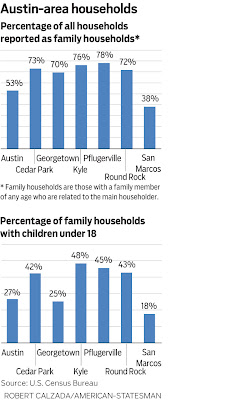The area where I live in Austin--South Lamar, just a mile from downtown--is undergoing a dramatic transformation. Literally thousands of new apartment units are being built along with new bars, food trailers, and other urban amenities replacing used car lots and fender bender repair shops. Indeed, this construction trend makes sense given the boom in "footloose young singles" moving here. For several years now, Austin has been a top destination for people ages 25-34 moving to a new city
. For 2009-2011, we were the 5th top destination (after D.C., Houston, Denver, and Portland), and before that we were #1. Austin also made #5 on the Wall Street Journal's list of cities that will emerge as the hottest destinations after the recession for highly mobile, educated workers in their 20s.
Cities are thinking creatively about ways to attract these young adults. For example, last week I attended a meeting where the topic of discussion was cities' removal of regulatory barriers to micro apartments--apartments of around 300 square feet--to open up more affordable living options for the young adult set. Along South Lamar, the market is responding to the young adult population boom and corresponding tight rental housing market with the rapid construction of efficiencies and one bedrooms, although not yet at the micro level. Very few of the apartments units will contain two bedrooms, and three bedrooms will likely be non-existent.
 |
| Robert Caldaza/Austin-American Statesman |
This limited range of bedroom counts and apartment sizes is unfortunate, at both ends of the spectrum. At some point, I hazard a guess that at least half of these young hipsters are going to abandon their footloose tendencies and have children (if they haven't already) and, low and behold, they will no longer want to live in an efficiency apartment. At the same time, they will find a dearth of family-friendly housing options they can afford in the urban core. To retain these new families in Austin (and avoid becoming like San Francisco which has become nearly void of families), Austin needs to figure out how to provide a fuller range of housing types--beyond just efficiency apartments for young single adults--
that fit our city's vision for a denser urban form. Otherwise, we will do nothing to contain urban sprawl and will continue to see families fleeing Austin to bedroom communities in surrounding cities along with all their spending power. The suburban cities surrounding Austin have seen far higher rates of population growth than Austin has, fueled in large part by families' demand for more affordable, kid-friendly housing types.

In the coming few weeks I plan to throw some ideas out there on bold steps we could take in Austin to make sure we are not only thinking creatively about how to attract young adults, but also how to retain them as they grow older and have children.



